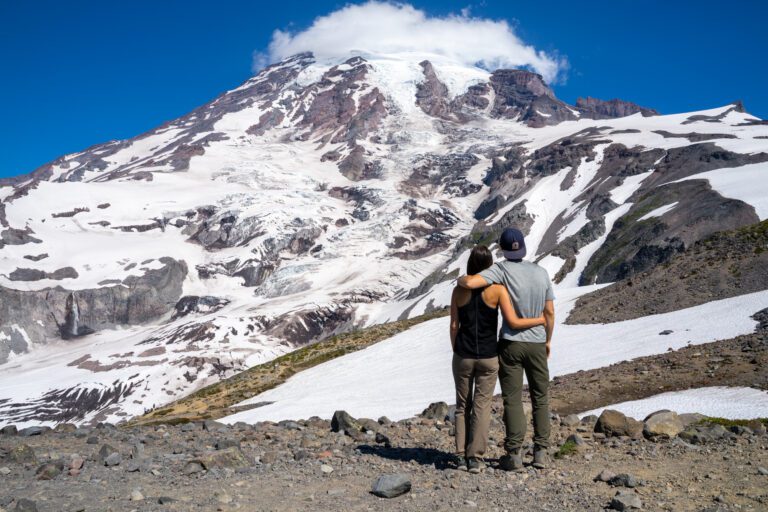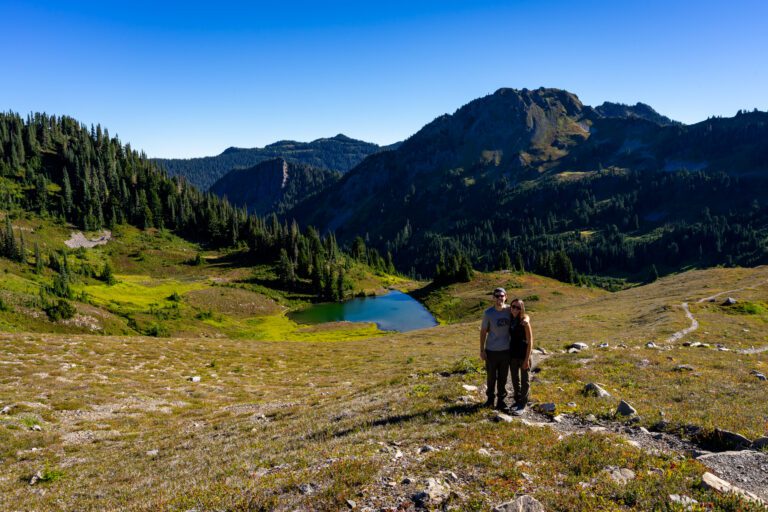How to Make Camp Coffee: The 9 Best Ways to Make Coffee While Camping
I get it – you love coffee, you’re going camping, and you want to figure out how to make coffee camping without sacrificing the quality of your morning brew. If you’re looking for a guide that helps you figure out how to make barista-level coffee while camping, you’re in the right place. I take my coffee seriously – some, including my wife, might use the word “snob” – and being out in the wilderness doesn’t change the fact that I just don’t like drinking gross coffee.
At home, I have a morning ritual that includes grinding fresh coffee on my Baratza Encore and using a scale to make a perfect cup of pour over coffee using my trusty Kalita Wave.
We spent a full six months on the road last year, living in our van and road tripping around the western United States. I’ve tried most of the ways that you could make coffee at camp, and I have some pretty strong opinions about the best way to make coffee camping. Whether you’re looking to make a perfect, barista-worthy cup of coffee, or you want something that’s easy and simply not offensive, I’ve got the information you need.
Below, you’ll find 9 different ways to make coffee while camping, ranked.
Disclaimer: Some of the links in this post, like hotel and vacation rental links, are affiliate links, meaning at no additional cost to you we make a little bit of money if you click through and book. That being said, we would absolutely never recommend something to you that we don’t stand behind 100%.
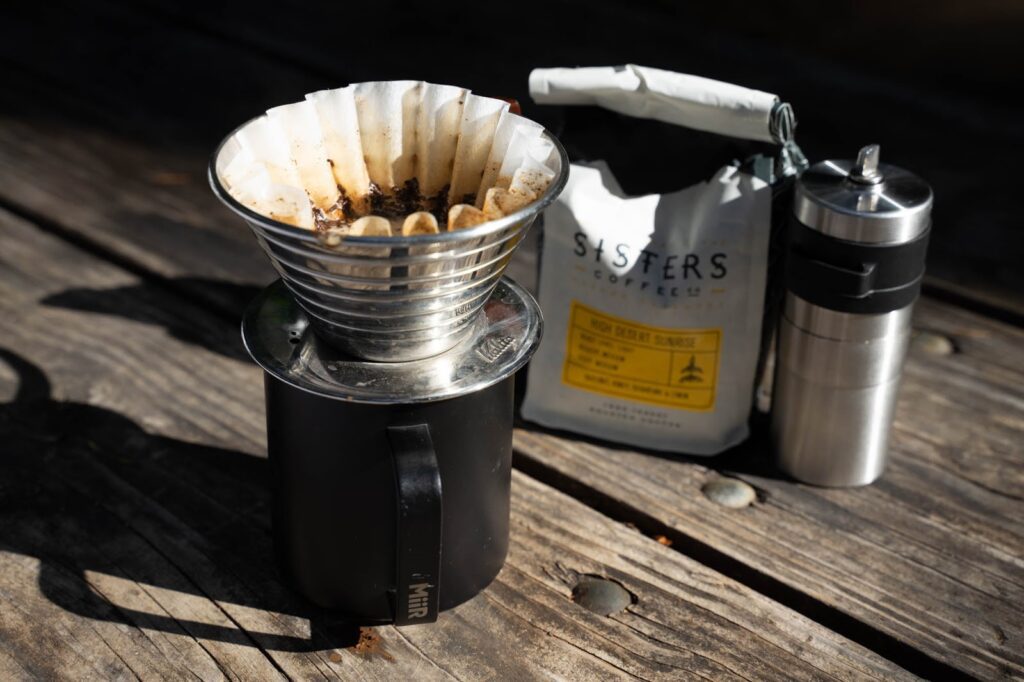
How to Make Coffee While Camping: 9 Brew Methods for Camp Coffee
Now that we’ve covered the non-coffee equipment it’d be good to have, onto the coffee! Here are nine ways to make coffee when camping, ranked by me, a coffee snob who makes pour over coffee for myself every single morning, at home and on the road.
Aeropress (#1 Best Way to Make Coffee Camping)
I’ve tried most of the different ways to make camp coffee, and my conclusion is that the Aeropress is the best combination of portability, ease of use, and cup of coffee out there when it comes to making coffee on the road.
I’ve traveled with it all over both the United States and the world, and it’s my #1 recommendation for coffee lovers who want a convenient and portable way to make a good cup of coffee while they’re camping.
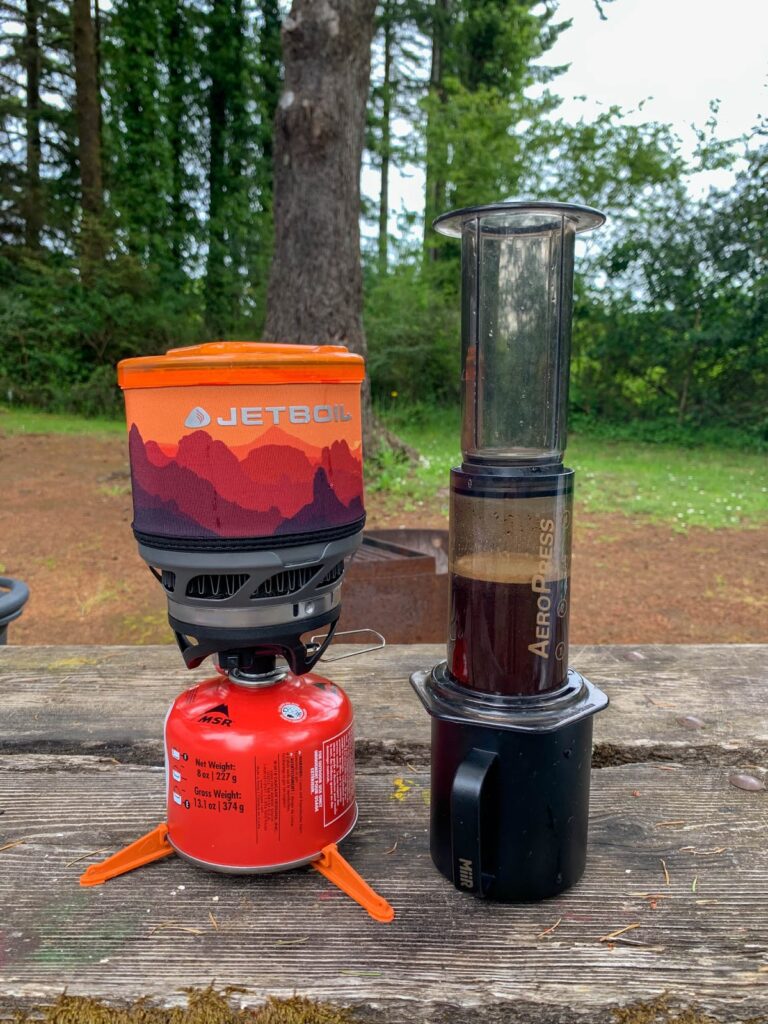
You’ll need the Aeropress itself, which basically folds into itself, making it super easy to pack in a duffel or in your kitchen box, along with their filters, which are equally portable.
Here is the exact recipe I use. Basically, you’ll need ground coffee, hot water, and a mug, and that’s about it!
It’s quick and easy, and can make a damn good cup of coffee, especially for camping.
Pour Over Coffee for Camping
First of all, there’s absolutely no reason you can’t simply bring your pour over setup from home with you on the road. That’s probably the best solution if you’re doing a weekend camping trip, rather than making an investment in some other equipment.
However, since we lived in our Honda Odyssey for about six months on the road last year, that’s not really an option for me.
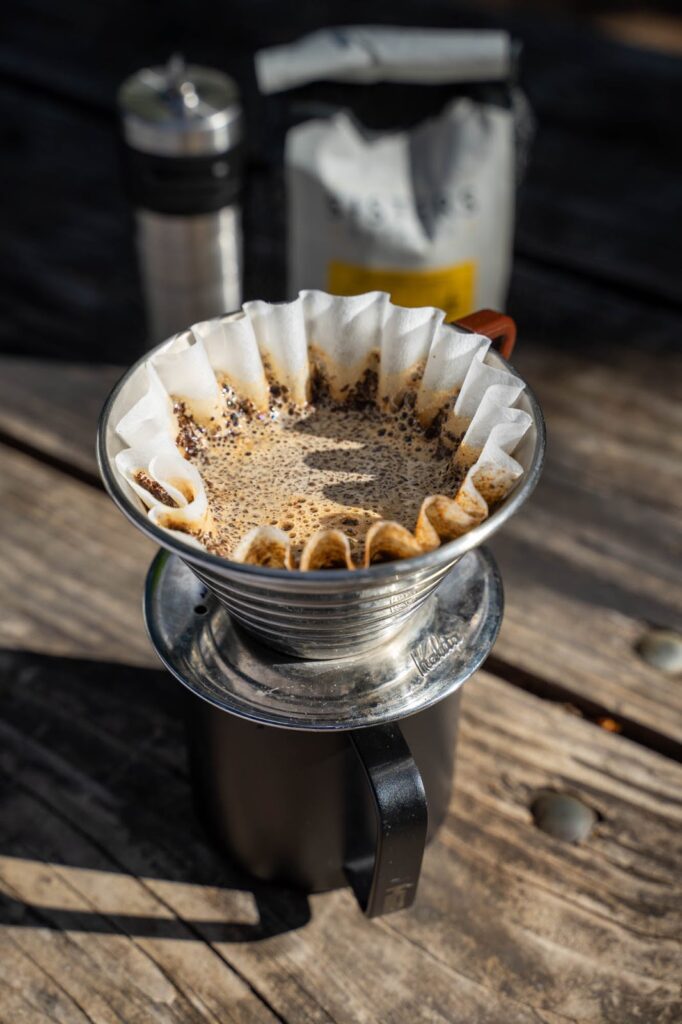
This is the most labor-intensive method on this list, and also the most intricate. But if you’re looking for a barista-level cup of coffee, this is probably the best method.
There are a bunch of options in terms of what brewing equipment to use, but the main thing to think about is size and weight. In general, something that is metal or plastic is going to be a better option than the usual ceramic brewers you see in your local coffee shop.
Here are three good options for making pour over coffee at camp.
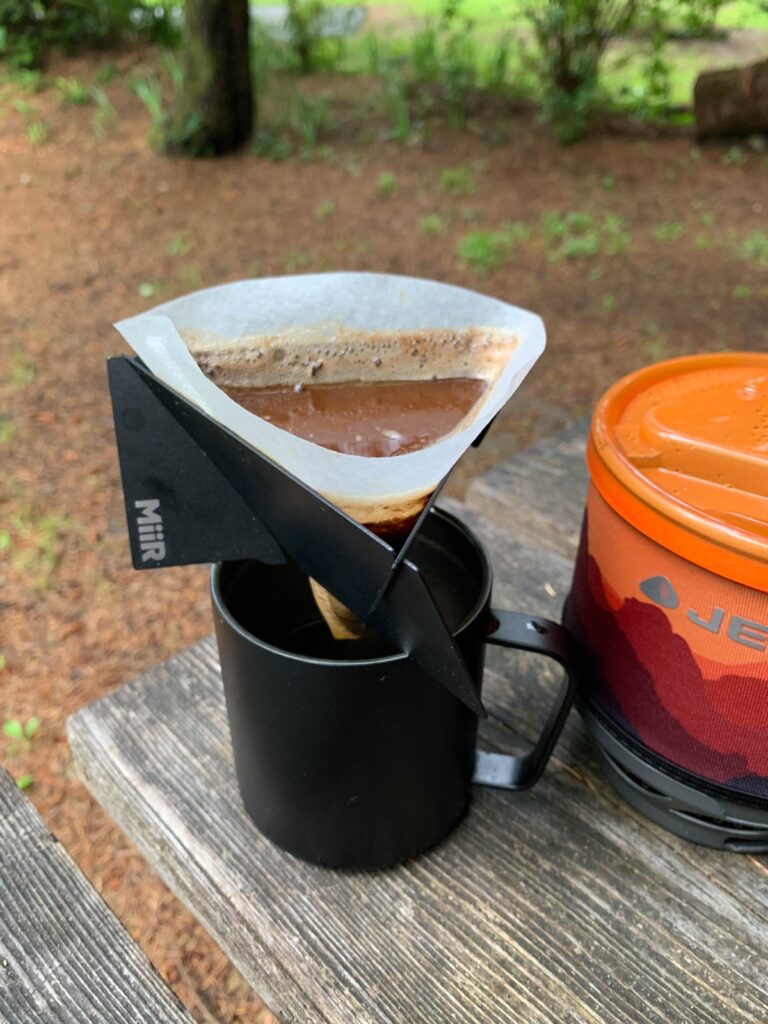
Miir Pourigami: Oh look, another Miir product! I remember when they unveiled this super innovative product and I immediately jumped on it because it’s such a good idea! I still haven’t quite dialed in the grind size / brewing ratio, but I’m working on it! The way it works is you connect the three pieces together to form a triangle-shaped cone, add a filter (you’ll have to buy their filters, which are specifically made for this device), and attach it to your mug. Add the coffee, pour your water in like you would for any other pour over option, and voila! Then, when you’re done, it packs down into a tiny footprint, roughly the size of a credit card (6.2cm x 12.7cm x 2.4mm unassembled, weighs 4oz). Click here to check it out on Miir.com.
Kalita Wave: This is my preferred brewing method at home, and the reason it makes this list is the fact that it’s relatively compact and lightweight. It’s a forgiving brewing method because the flat bed regulates the flow, so even if you grind the coffee wrong or pour in too much water, it’s going to produce a decent cup of coffee. Click here to check prices and reviews at Equator Coffees.
GSI JavaDrip: An ultralight solution that comes in under $12? Consider me sold, at least for backpacking where the weight and size are the main concern. It’s probably one of the best ways to make coffee backpacking, since it comes in at just 0.4 ounces, but I’d go for the two options above if you’re car camping. Click here to check prices and reviews at REI.
French Press

I’m not usually a huge fan of the French Press because it usually produces a full-bodied coffee and loses some of the brighter flavors that I like in my fruity coffees, but when you’re camping, it’s a solid option.
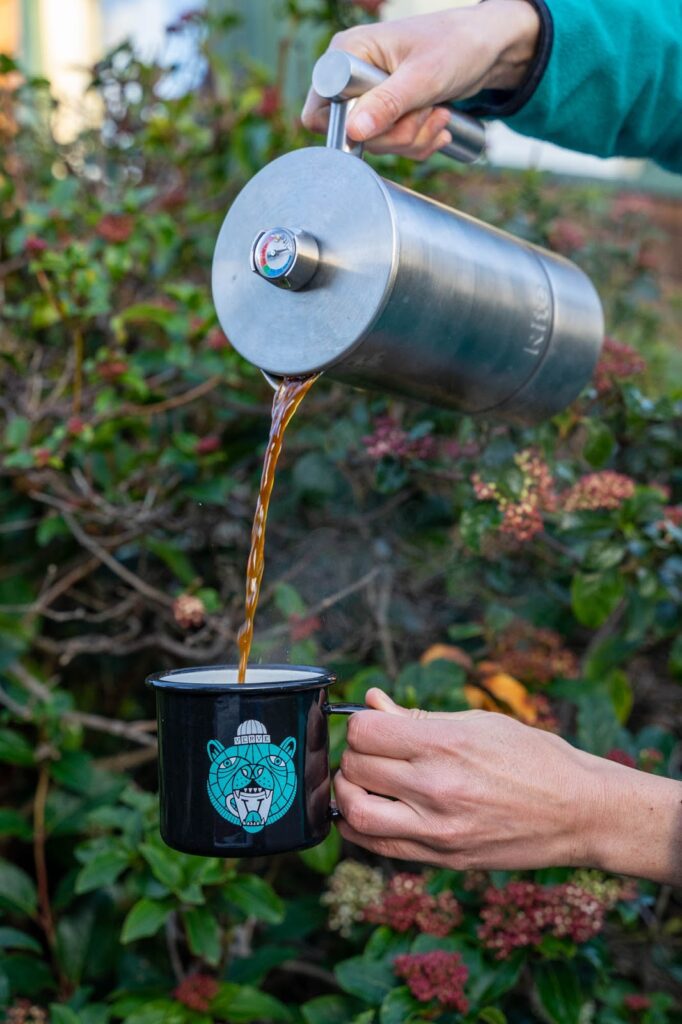
All you need is hot water, the press, and a mug, which makes it easy to bring camping without having to worry about filters and other pieces of equipment you might need. The cleanup is kind of a pain, but it’s not too bad.
The classic Bodum French Press will do just fine. It’s super affordable, but you’ll need to be a little bit careful with it. I’ve lost two of them to either falling out the back hatch and shattering upon hitting the ground, or dropping it off the picnic table (both user error, obviously).
The concern about a French Press shattering – which has happened to me multiple times before – is solved with this shatter-proof French Press by GSI Outdoors.
Cold Brew Concentrate
If you’re looking for something you can make in large batches for a bigger group, then you’re going to want to look at cold brew concentrate.
This is probably the easiest method on this list – you don’t even need to boil water! – but that’s also the downside. You can’t really make this hot, so on a crisp fall morning where all you want is a warm cup in your hands when you wake up, it’s not going to be the best option.
You have two choices here.
You can make your own, which is relatively easy to do at home. Here is a good guide for how to make cold brew concentrate at home. Once it’s ready, make sure it’s in a container in your cooler and it’ll be good for about five days after you make it. When you’re ready to drink it, don’t forget that you need to dilute the concentrate! Usually somewhere between 1:1 and 2:1 (water:coffee) works best, but you can adjust to your personal tastes and preferences.
The other option here is to buy it pre-packaged. All sorts of brands have a big container of cold brew concentrate that you can buy and bring to camp. Then, in the morning, just add the concentrate to your mug, dilute it with somewhere between 1:1 and 2:1 (water:coffee), and off you go!
I like Wandering Bear, which you can find on their website, but you can sometimes find big bottles of Stumptown cold brew concentrate in local stores, which is the gold standard of store-bought cold brew concentrate if you ask me.
Single Serve Cold Brew
For sunrise adventures, I swear by single serve cans of cold brew. And the brand I love most is easily Rise Brewing Co. This is one of the more expensive ways to make coffee here, but I do love some nitro cold brew!
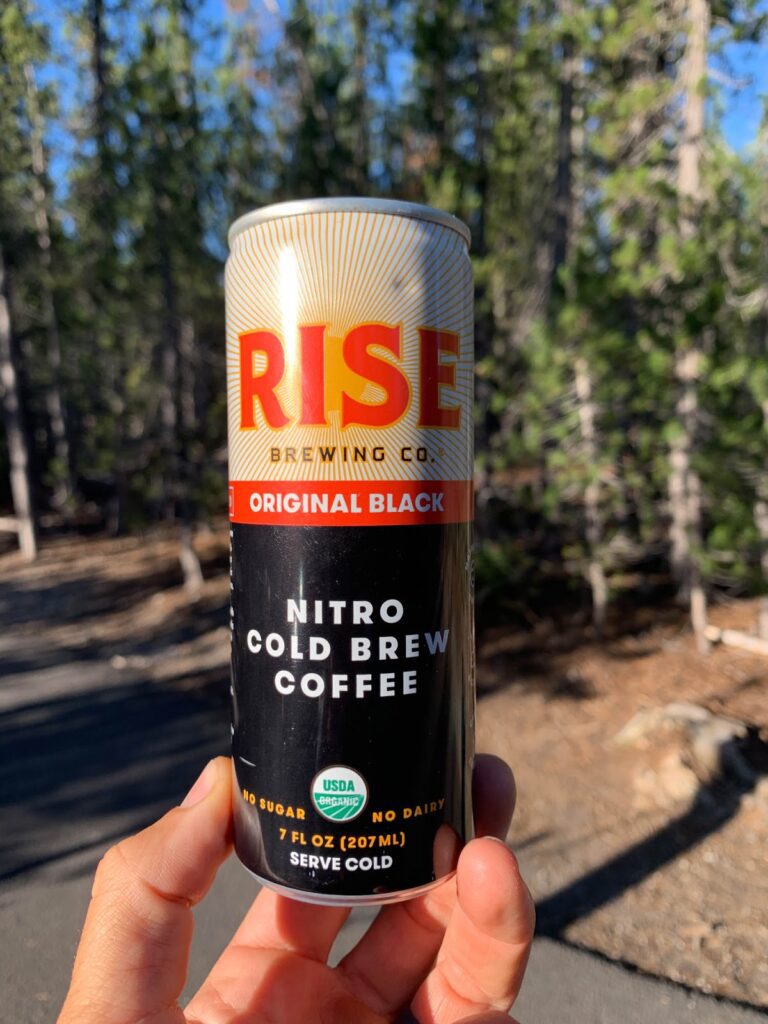
This is a good option for a couple of people and a couple of nights of camping, otherwise it starts to get expensive and creates a lot of waste.
Steeped Coffee
I remember the first time I came across the idea of making coffee like you make tea – in a bag. I was at the Counter Culture Coffee Tasting at Ten in Seattle, and they had just partnered with a company called “Steeped” on a test project to make their coffee into a portable, steepable solution for people on the go. They handed me two bags to try, and curious as I am, I went home and immediately brewed one of them.
I like the idea, but the coffee just isn’t nearly as good as making it fresh. Which is not a surprise, I suppose – it should probably be compared to making instant coffee instead, which it is undoubtedly better than.
Essentially, you make your hot water, pour it in your mug, and add your bag of coffee (again, remember it’s like a tea bag). You dunk it up and down for 10-15 seconds, and then let it steep for another two minutes or so.
The best product to go with if this method intrigues you is definitely the original Steeped product if you’re buying it online. You can also find Steeped at local coffee roasters who have partnered with them, on occasion.
Good Instant Coffee
No, I’m not talking about Starbucks Via. There’s a surprising amount of actually good instant coffee popping up, and while it’s certainly not as good as making coffee using freshly ground beans and one of the brewing methods above, it’s also not as bad as you remember.
Instant coffee is one of the best ways to enjoy coffee in the backcountry – all you really need is hot water and a cup, and it’s super lightweight and portable. If you don’t want to deal with the hassle and clean up involved with using one of the methods above – like pour over or the Aeropress, then this might be the way to go.
If you’re looking for above-average instant coffee, look at Waka or Alpine Start. Neither will knock your socks off, but neither is offensive.
If you’re looking for an upgrade, some of my favorite coffee roasters like Verve and Coava are making some great instant coffee, but it’s pricey.
Single Serve Pour Over Coffees
I’ve started to notice more and more single-serving pour over coffees on the market. One of the first I came across years ago was Kuju Coffee, who I think is probably the best of the bunch in terms of non-specialty coffee (plus, they do some cool stuff “off the field” too).
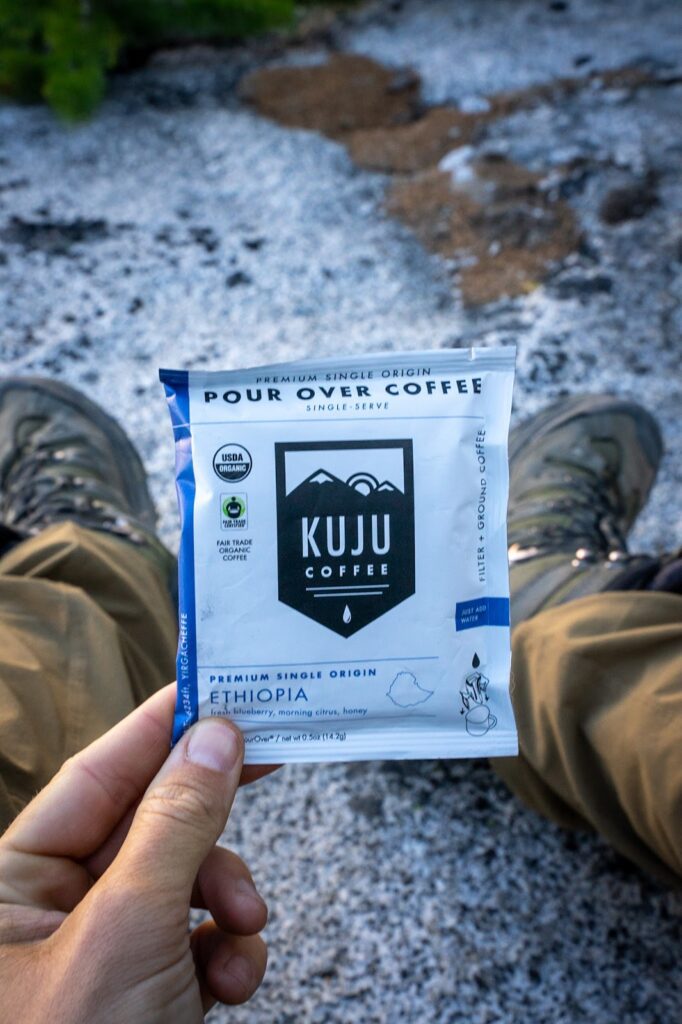
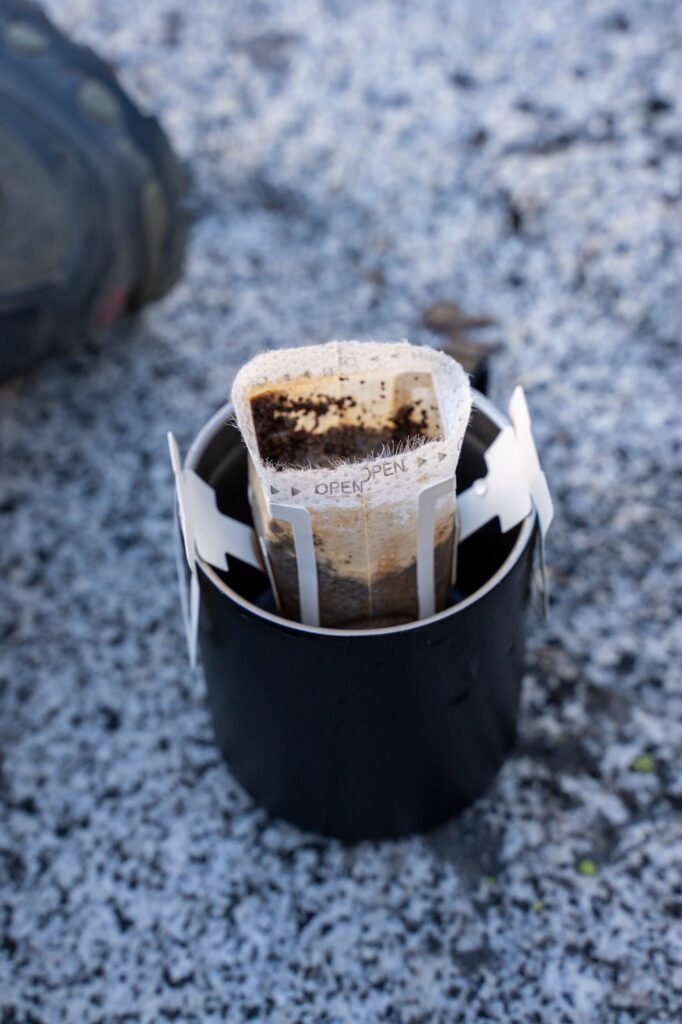
However, if you’re really looking for a treat, there are some great options from Dripkit, who uses Verve Coffee and Stumptown Coffee, among others.
Why isn’t this higher on the list? It’s an awful lot of packaging and materials for each cup of coffee.
Cowboy Coffee / Percolator
I mean, you COULD just boil water in a pot and add coffee and half strain it out before pouring it into a cup, but WHY would you do that to yourself? If it’s your only option, well, coffee is coffee I guess? But if you’re actually looking for a good cup of coffee, I think you can do better.
And I feel the same way about the percolators out there, but I would put them slightly above the just-a-pot method.
Non-Coffee Essentials for Making Coffee at Camp
Before we get to different ways to make coffee, here are some other tools you may or may not need, depending on which method you use.
Miir Camp Cups
These days, there’s a nearly unlimited number of camp mugs that you could use. However, we strongly recommend that you check out Miir’s Camp Cups, which are the best around.
Not only is the product amazing, but they also have a code on the bottom of the mug that you can plug in on their website to donate a portion of the revenue from your purchase to your choice of one of the causes that they are supporting.
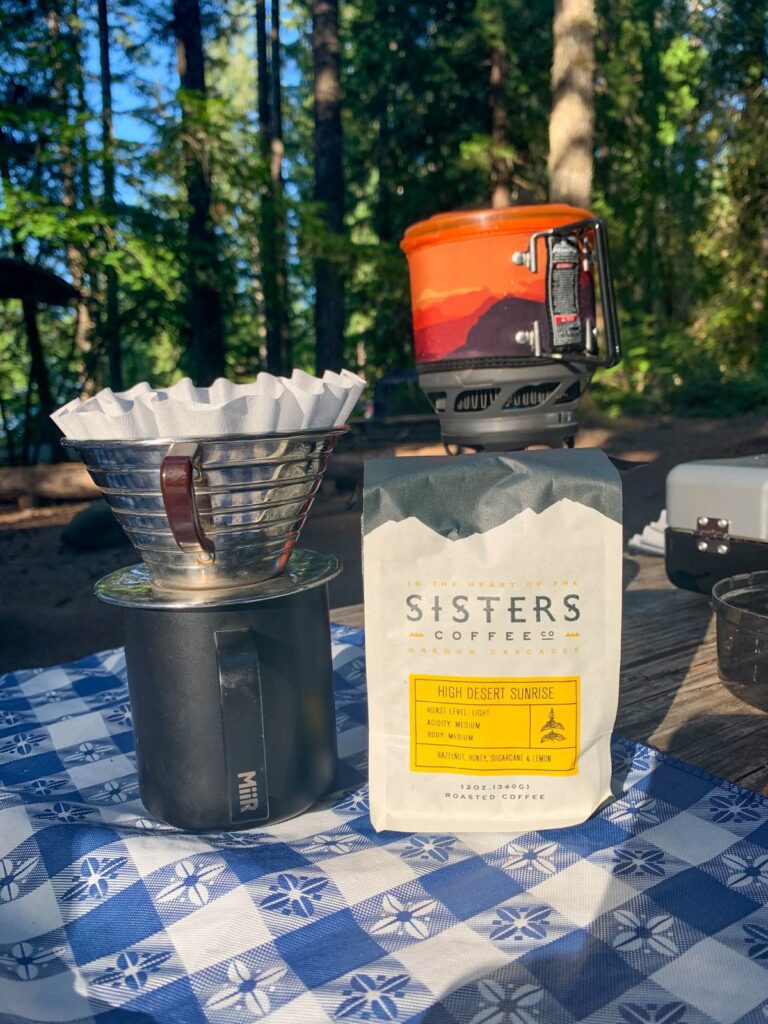
You know how some companies note that they donate a percentage of profits to the causes that they’re supporting? Miir donates a percentage of revenue, which means even if they don’t make a profit, they’re still doing good in the world. I heard their founder talk about it on a podcast, and I thought that was a really good point that I hadn’t thought about before. Read more about them here.
I also have their travel mug, which I used to use daily on my way to work, but find myself using less when I’m camping.
Spoiler: I have basically every single product they make.
Camp Stove
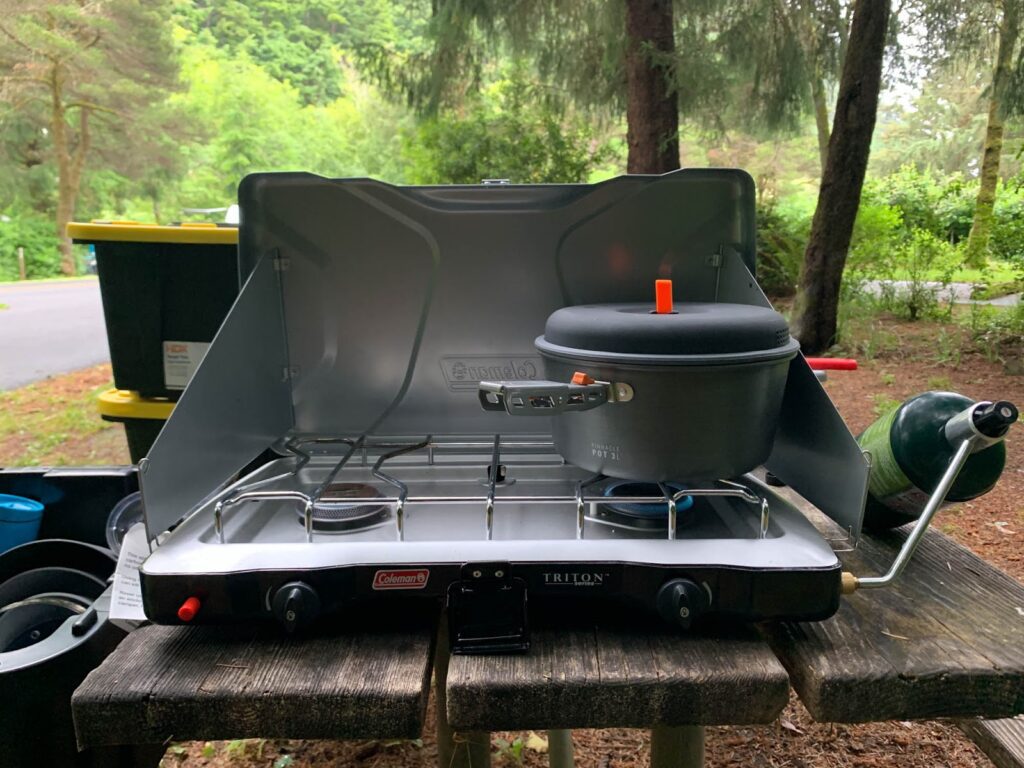
Have you ever tried to boil coffee over a campfire before? Between setting up the fire, and then boiling the water, you’re looking at probably 30-45 minutes. And that’s if you do it all perfectly.
I feel the same way about camping coffee that I do about cooking while camping – it sounds sexy to make your food or coffee over a campfire, but at the end of the day you’re going to be A LOT happier if you invest in a camp stove. No more half-done potatoes that you decide to eat because you can’t wait another 30 minutes for the foil-wrapped meal to cook properly.
You’ll also need a pot to boil the water in, and fuel for the stove.
We have the Coleman Triton 2-Burner stove, but the temperature control isn’t great (it’s off, hot, or super hot) and we’d probably get the Eureka Ignite 2-Burner instead.
Jetboil
You can obviously boil coffee on your camp stove in a pot and call it good, but it’s woefully inefficient and a pain to set up just to make a cup of coffee. All before you’ve had your morning coffee!
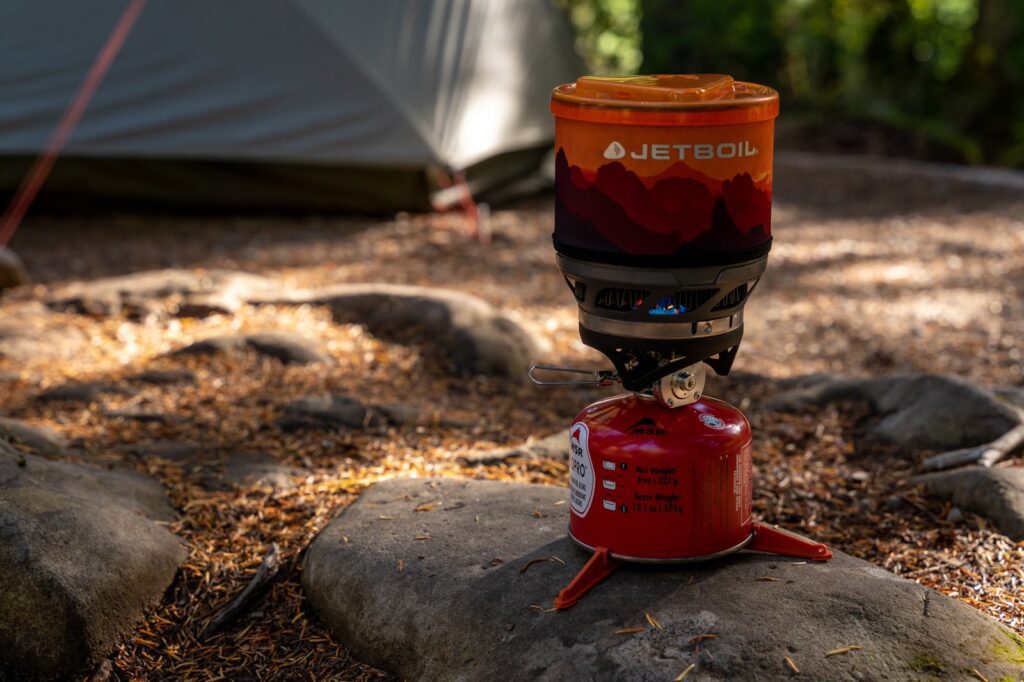
99% of the time, I use our Jetboil, which is a backpacking essential that we have with us on all of our road trips, camping trips, and backcountry adventures.
It packs down super small, and sets up in less than a minute flat. You’ll have boiling water ready for coffee making in less than five minutes, which gives you just enough time to grind your coffee fresh using your….
A Coffee Grinder
Look, every coffee snob knows you need to grind the coffee fresh to get the best flavor. Why would making coffee while camping be any different?
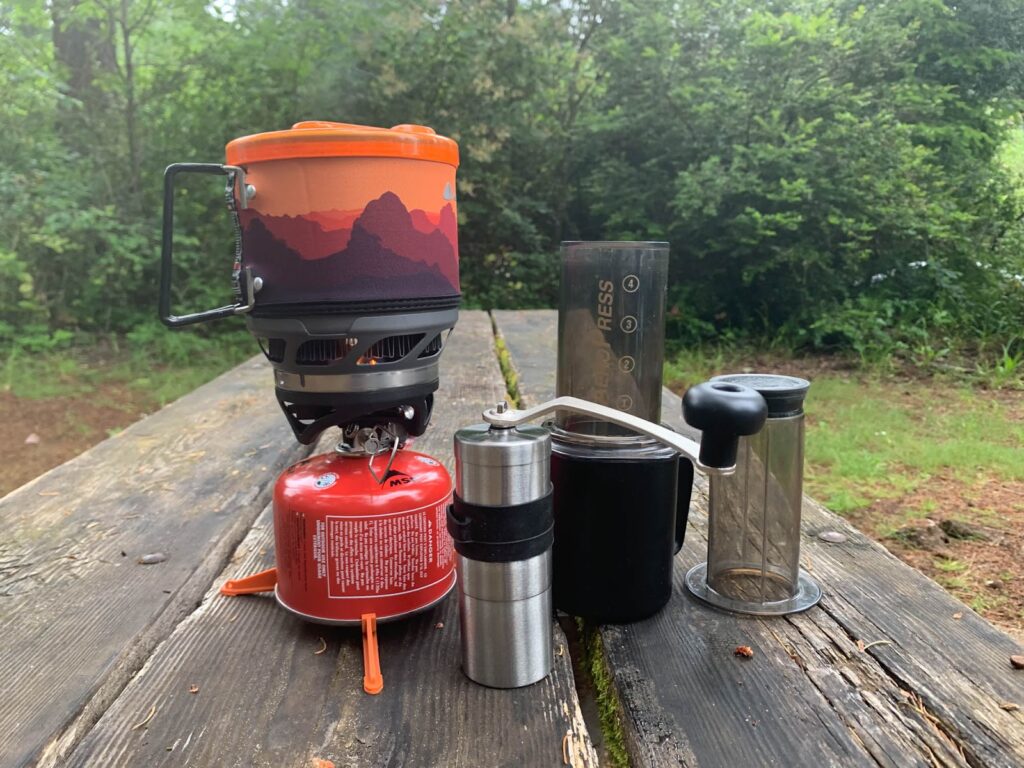
Obviously, you only would need a grinder if you choose one of the methods that requires fresh coffee, like pour over or French Press, and not if you use instant coffee or one of the single-serve pour over options.
I use the Porlex Mini Grinder when we’re on the road, and while it’s no Baratza Encore, it’s certainly a good enough grinder to use at camp.
Optional: A Food Scale
If you’re like me, you probably meticulously measure out your coffee and water every morning during your pour over coffee ritual at home. I also sometimes do that while camping, which means you need a food scale. You can get them both cheap and small, which makes the perfect camping companion for coffee lovers who won’t settle for anything less than barista-level coffee at camp.
I have this food scale that lives in our camping box.

